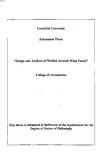JavaScript is disabled for your browser. Some features of this site may not work without it.
| dc.contributor.advisor | Zhang, Xiang | |
| dc.contributor.author | Theos, Athanasios | |
| dc.date.accessioned | 2009-10-29T17:00:49Z | |
| dc.date.available | 2009-10-29T17:00:49Z | |
| dc.date.issued | 2005-12-05 | |
| dc.identifier.uri | http://hdl.handle.net/1826/3901 | |
| dc.description.abstract | Nowadays, increasing manufacturing cost effectiveness becomes a vital condition for the commercial success of the next generation of large wide body aircrafts. Welding is a very strong candidate process to be used in manufacturing, allowing both sensible cost reductions and structural efficiency. The main aim of the work is to study the fatigue crack propagation in welded structures. The study is focused on the effect of welding residual stresses to the damage tolerance behaviour of the structure. The welding technique under investigation is the Variable Polarity Plasma Arc (VPPA). Two stringer panels were designed, one tension panel to simulate the lower wing skin cover and one compression panel to mimic the upper wing skin cover. The main design driving force for the upper stiffened panel is buckling since it is under compression. Damage tolerance is the main design criterion for the lower stiffened panel due tensile fatigue loading. Design of the end- fittings for the tension stiffened panel was also carried out using finite element modelling in order to ensure uniform stress distribution at the cross section of the test area of the structure. A fatigue analysis at the various locations of the bolts and at the weld line has been performed. This is necessary in order to ensure that the crack initiation site comes from the weld line rather than from the fastener holes at the end-fittings during the fatigue testing. The research was focused on fatigue crack growth behaviour of welded aluminium panels. The FE model of the CCT coupon is the main tool for the comparison of the fatigue crack behaviour between the parent and the welded coupons. Furthermore AFGROW software is used in conjuction with the output of the FE model to compare the experimental and numerical results in terms of fatigue crack growth lives of welded coupons. In welded coupons a faster crack propagation growth was demonstrated at the region of the weld line and the heat affected zone (HAZ) due to the tensile welding residual stresses. Away from this region, a decrease in crack growth took place due to the compressive welding residual stresses in this area. Finally, a calculation effort in large-scale stiffened panels was made in terms of the stress intensity factor for both welded and non-welded cases. Possible future work was also addressed in such large-scale structures. | en_UK |
| dc.language.iso | en | en_UK |
| dc.publisher | Cranfield University | en_UK |
| dc.rights | © Cranfield University, 2005. All rights reserved. No part of this publication may be reproduced without the written permission of the copyright holder. | en_UK |
| dc.title | Design and analysis of welded aircraft wing panels | en_UK |
| dc.type | Thesis or dissertation | en_UK |
| dc.type.qualificationlevel | Doctoral | en_UK |
| dc.type.qualificationname | PhD | en_UK |
